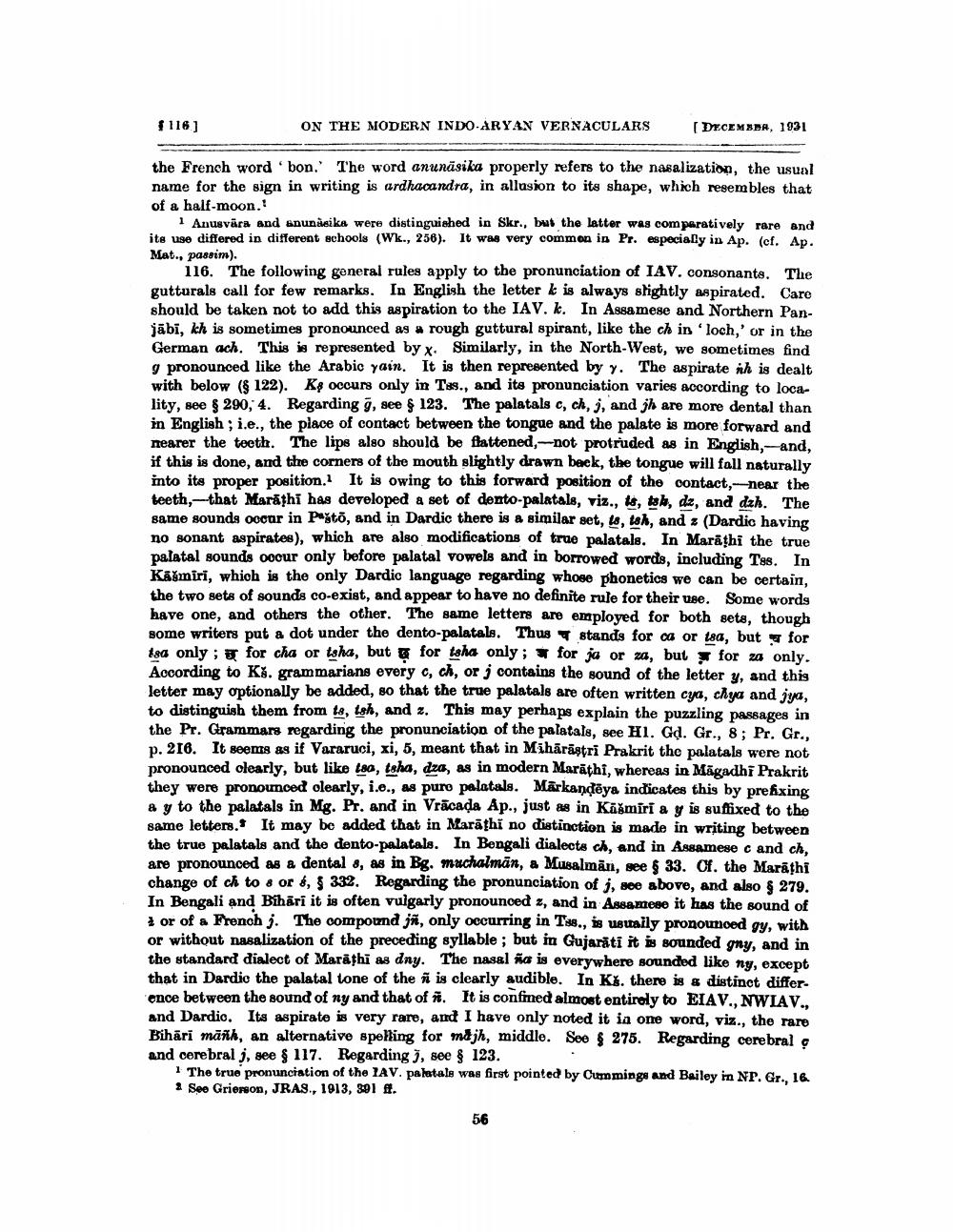________________
f116]
ON THE MODERN INDO-ARYAN VERNACULARS
(DECEMBDA, 1931
the French word 'bon. The word anunāsika properly refers to the nasalization, the usual name for the sign in writing is ardhacandra, in allusion to its shape, which resembles that of a half-moon.
Anusvära and anunsika were distinguished in Skr., but the latter was comparatively rare and ite use differed in different schools (Wk., 256). It was very common in Pr. especially in Ap. (cf. Ap. Mat., passim).
116. The following general rules apply to the pronunciation of IAV. consonants. The gutturals call for few remarks. In English the letter k is always slightly aspirated. Care should be taken not to add this aspiration to the IAV. k. In Assamese and Northern Panjābi, kh is sometimes pronounced as a rough guttural spirant, like the ch is 'loch,' or in the German ach. This is represented by x. Similarly, in the North-West, we sometimes find 9 pronounced like the Arabic yain. It is then represented by y. The aspirate ih is dealt with below (122). K occurs only in Tss., and its pronunciation varies according to locality, see 290, 4. Regarding 7, see $ 123. The palatals c, ch, j, and jh are more dental than in English: i.e., the place of contact between the tongue and the palate is more forward and nearer the teeth. The lips also should be flattened, -not protruded as in English,--and, if this is done, and the corners of the mouth slightly drawn back, the tongue will fall naturally into its proper position. It is owing to this forward position of the contact,-near the teeth.-that Marathi has developed a set of dento-palatals, viz., ts, tsh, dz, and dzh. The same sounds oocar in Pešto, and in Dardic there is a similar set, 18, tsh, and (Dardic having no sonant aspirates), which are also modifications of true palatals. In Marathi the true palatal gounds oocur only before palatal vowels and in borrowed words, including Tes. In Kašmiri, which is the only Dardic language regarding whose phonetics we can be certain, the two sets of sounds co-exist, and appear to have no definite rule for their use. Some words have one, and others the other. The same letters are employed for both sets, though some writers put a dot under the dento-palatals. Thus stands for ca or 18a, but for 180 only; v for cha or tsha, but for tsha only ; * for jo orza, but for za only. According to Kš. grammarians every c, ch, or j contains the sound of the letter y, and this letter may optionally be added, so that the true palatals are often written cya, chya and jya, to distinguish them from ta, Ish, and z. This may perhaps explain the puzzling passages in the Pr. Grammars regarding the pronunciation of the palatals, see Hl. Gd. Gr., 8; Pr. Gr., p. 216. It seems as if Vararuci, xi, 5, meant that in Mihärästri Prakrit the palatals were not pronounced clearly, but like 18a, tsha, dza, as in modern Marathi, whereas in Māgadhi Prakrit they were pronounced clearly, i.e., as puro palatals. Markandeya indicates this by prefixing ay to the palatals in Mg. Pr. and in Vrācada Ap., just as in Kašmiri ay is suffixed to the same letters. It may be added that in Marathi no distinction is made in writing between the true palatals and the dento-palatals. In Bengali dialects ch, and in Assamese c and ch, are pronounced as a dental 8, as in Bg. muchalmān, a Musalman, see 6 33. Cf. the Marathi change of ch to s or , § 332. Regarding the pronunciation of j, see above, and also $ 279. In Bengali and Bihari it is often vulgarly pronounced 2, and in Assamese it has the sound of
or of a French j. The compound jñ, only occurring in Tss., is usually pronounced gy, with or without nasalization of the preceding syllable; but in Gujarati it is sounded gny, and in the standard dialect of Marathi as dny. The nasal na is everywhere sounded like ny, except that in Dardio the palatal tone of the ñ is clearly audible. In Ks. there is a distinct difference between the sound of ny and that of i. It is confimed almost entirely to EIAV., NWIAV.. and Dardio. Its aspirate is very rare, and I have only noted it in one word, viz., the rare Bihari mänh, an alternative spelling for majh, middle. Soe & 275. Regarding cerebral and cerebral j, see § 117. Regarding ), see § 123.
1 The true pronunciation of the IAV. palatals was first pointed by Cummings and Bailey in NP. Gr., 16 2 See Grierson, JRAS., 1913, 391 ft.
56




